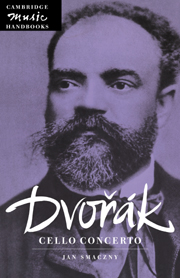Book contents
- Frontmatter
- Contents
- Preface and acknowledgements
- 1 Dvořák and the cello
- 2 Preludes to the Concerto
- 3 The Concerto and Dvořák's ‘American manner’
- 4 ‘Decisions and revisions’: sketch and compositional process
- 5 The score I: forms and melodies
- 6 The score II: interpretations
- 7 Performers and performances
- Notes
- Select bibliography
- Select discography
- Index
5 - The score I: forms and melodies
Published online by Cambridge University Press: 02 December 2009
- Frontmatter
- Contents
- Preface and acknowledgements
- 1 Dvořák and the cello
- 2 Preludes to the Concerto
- 3 The Concerto and Dvořák's ‘American manner’
- 4 ‘Decisions and revisions’: sketch and compositional process
- 5 The score I: forms and melodies
- 6 The score II: interpretations
- 7 Performers and performances
- Notes
- Select bibliography
- Select discography
- Index
Summary
A symphonic concerto?
There is widespread consensus among commentators that the Cello Concerto is the most successful of Dvořák's works in the form. Indeed, the essential ‘rightness’ of the piece, and in particular its opening orchestral tutti, is often established in relation to a perceived lack of success in his Piano and Violin Concertos. For Alec Robertson, with the Cello Concerto Dvořák had ‘got concerto form just where he wanted it’. Robertson rarely gave wholehearted approval for any work by Dvořák in his Master Musicians study of the composer; for him the first movement of the Violin Concerto was ‘Too long for an introduction to the extensive slow movement’ and ‘too short for what is called first-movement form’, and the Piano Concerto ‘has not so much a warm heart as cold feet’. In the case of the Cello Concerto, Robertson presumably felt he was on safer ground in praising the work, since he immediately follows his complimentary introduction to it with Brahms's reaction as recounted to Tovey by the German cellist, Robert Hausmann: ‘Why on earth didn't I know that one could write a Violoncello Concerto like this? If I had only known, I would have written one long ago!’
Alongside the general approval rating for the Cello Concerto is a widely held perception that it is both symphonic and something of a return to earlier, presumably pre-American period, practices. In A Companion to the Concerto, Joan Chissell places the Cello Concerto in ‘The Symphonic Concerto’ division of the chapter entitled ‘The Concerto after Beethoven’.
- Type
- Chapter
- Information
- Dvorák: Cello Concerto , pp. 42 - 63Publisher: Cambridge University PressPrint publication year: 1999



